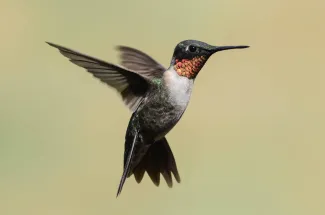
Hummingbirds are welcome visitors to many Oklahoma yards. Not only do many plants depend on them for pollination, but the tiny birds also provide hours of prime time wildlife watching. Several hummingbird species visit the Great Plains, but the ruby-throated hummingbird is the most common of these. The black-chinned hummingbird is found in the western third of the Southern Great Plains, while the broad-tailed and rufous hummingbirds occasionally are spotted during fall migration.
Hummingbirds have extremely high metabolic rates and energy demands, forcing them to consume up to half their weight in insects and eight times their weight in fluids every day. Their wings beat 70 times per second while hovering and up to 200 times per second during courtship dives. The small birds also expend a lot of energy when they migrate, flying 1,000 miles during two trips across the Gulf of Mexico each year.
You can help hummingbirds meet their energy requirements by planting a hummingbird garden and by setting out a sugar-water feeder. Most backyard naturalists like to view hummingbirds up close, so consider this before you hang your bird feeder or begin planting your nectar-producing plants. You may want to combine natural and artificial nectar sources by placing a hummingbird feeder in a garden designed just for hummingbirds.
Artificial Feeders
Even small yards offering limited space can be attractive to hummingbirds. Backyard naturalists have found that birds will feed from hanging potted plants or sugar-water feeders on patios and decks. The birds feed most comfortably from feeders at least 2 feet above ground.
The long-term way to attract hummingbirds is by providing nectar-producing plants in sunny areas of your yard. However, you can supplement their natural diet and draw in these little birds with sugar-water feeders. Several important guidelines should be followed when providing a sugar solution:
- Use a solution of four parts water to one-part white granulated sugar. Dissolve the sugar in warm water and then cool the mixture before using it. Refrigerate what you do not use.
- Clean feeders every three or four days with hot water and vinegar to remove bacteria and fugus molds. Purchase a feeder that can be taken apart and placed in the dishwasher.
- Do not use honey, which could contain fungi that may kill hummingbirds.
- Do not use red dye in your solution. Use a feeder that has red ports instead.
- To discourage bees from landing on feeder ports and the suspending wire, use vegetable oil. The plastic guard, usually colored yellow, increases the distance from the opening to the sugar water beyond the reach of the bee’s tongue.
- Do not hang feeders in bright sunlight; place them in partially shaded areas.
- Place your feeders out in April and leave them up until about November 1, unless you have observed a week without hummingbird activity. Hummingbirds will migrate whether or not your feeder is up. By providing a nectar source later in the fall, you’ll provide a quick energy source for any migrating hummingbirds that may come through your area, and you are more likely to be visited by a rare hummingbird.
- Hummingbirds are very territorial, so if you notice one hummingbird chasing another away from a feeder, set up a second feeder out of sight of the first one.
Creating a Hummingbird Garden
By planting native trees, shrubs, vines, and herbaceous plants that produce bright orange or red tubular blossoms, you will create a natural habitat to attract hummingbirds. Native plants are preferred because so many of the popular cultivated landscape plants do not produce sufficient nectar. Single-flowered blossoms are the best choice, because they produce much more nectar than do double-flowered blossoms and sterile hybris.
Layering the vegetation of your landscape is the best design for attracting hummingbirds. Build height into your landscape by planting flowering trees and installing trellises for vines to climb. Develop a good understory by planting shrubs under and around trees and establish ground cover by planting annual and perennial herbaceous plants.
Plants that produce flowers highly attractive to hummingbirds in Oklahoma (from Oklahoma Bird Life by F. M. and A. M. Baumgartner).
| Plant Name | Bloom Season |
|---|---|
| Trees and Shrubs | |
| Azalea | Spring-Summer |
| Buckeye | Spring |
| Glossy abelia | Spring-Summer-Fall |
| Herbaceous Plants | |
| Beard Tongue | Spring |
| Bergamot | Summer |
| Cardinal Flower | Spring-Summer-Fall |
| Columbine | Spring-Summer |
| Evening Primrose | Spring-Summer |
| Four O-Clocks | Spring-Fall |
| Gladiolus | Spring-Summer |
| Hollyhock | Summer |
| Lark Spur | Spring-Summer |
| Mints | Spring-Summer |
| Indian Paintbrush | Spring-Summer |
| Petunia | Summer-Fall |
| Phlox | Spring-Summer-Fall |
| Prickly Pear | Spring-Summer |
| Sage (especially red) | Summer-Fall |
| Sweet William | Summer |
| Yucca | Spring-Summer |
Share What You See
Hummingbird enthusiasts can share sighting details on eBird or iNaturalist, or at wildlifedepartment.com.
This content originally appeared in the Wildlife Department’s “Landscaping for Wildlife” guide. The full guide can be viewed here.
